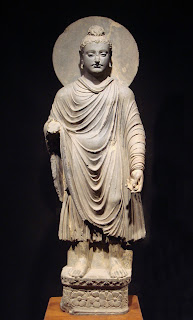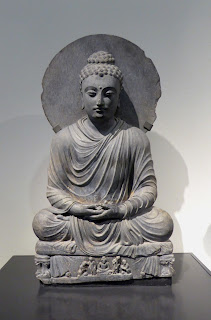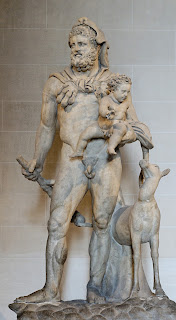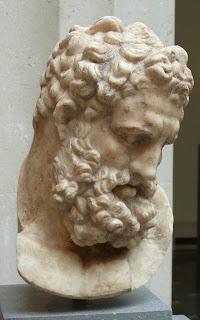Gandhara school of art was the epitome of cultural revolution in present day's west Pakistan and east Afghanistan during Kushan rule, of which Gandhara sculpture was an important part, depicting sculpture of Buddha
Gandhara art is of Greeco-Roman origin, combined with Indian artistic traditions
"Gandhara sculpture was influenced greatly by Greek culture, however, the impact of Romans was quite considerable as well"
Greek influence in Gandhara sculpture is observed in the form of Buddha's wavy hair, draperies covering both shoulders. footwear, Buddha the founder of Buddhism, under the projection of Greek God Herakles and so on. In fact, the very concept of man-God is attributed to Greeks. The Buddha's mythological statue can also be related to Greeks.
Some examples of Gandhara art depicts both Buddha and the Greek God Herakles from Greek Mythology. Stucco plaster, which was commonly observed in Greek art, was widely used in Gandhara artwork for the decoration of monastic and cult buildings. However, Gandhara sculpture owes as much to Roman art as it does to Greek art. As evident from the Gautam Buddha or Gautama Buddha, with a youthful Apollo-like face, dressed in garments resembling the scenes on Roman imperial statues. Gandhara sculpture incorporated many motifs and techniques from classical Roman art too as seen from vine scrolls, cherubs bearing garlands, tritons and centaurs. Additionally, the Gandhara art drew from the anthropomorphic traditions of Roman religions.
Buddha dressed in garments resembling those seen on Roman imperial statues. The realistic sculpture of Buddha is associated with Romans. The Roman style at Gandhara consists of relief panels adorning the wall surface around the exteriors of the shrines. Also, the similarity of a standing Buddha found at mardan to Roman emperor statues, one of the most famous and frequently cited examples of Roman element at Gandhara.
These influences can be well justified because of the strategic location, Gandhara school developed at. The region was on the crossroads of many cultural influences as it was in the vicinity of ancient silk route and on a passage to India.




Comments
Post a Comment